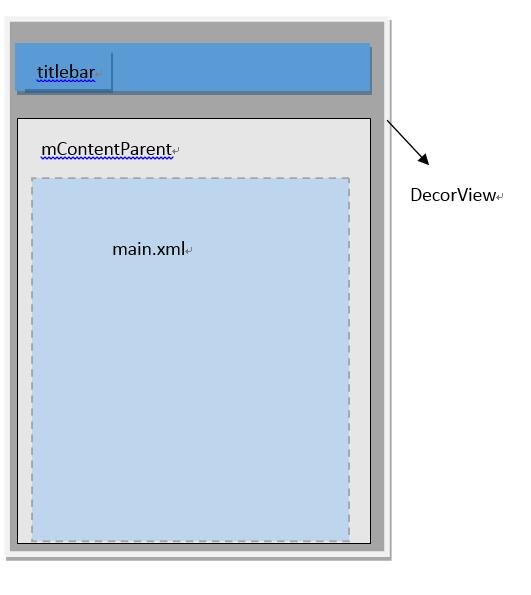Activity的源码
首先从setContentView这里调用的mWindow的 setConetView()
private Window mWindow; public void setContentView(View view) { getWindow().setContentView(view); initWindowDecorActionBar(); } public Window getWindow() { return mWindow; }
那么这mWindow什么时候初始化?
final void attach(...) { attachBaseContext(context); mFragments.attachHost(null /*parent*/); mWindow = new PhoneWindow(this, window, activityConfigCallback); mWindow.setWindowControllerCallback(this); mWindow.setCallback(this); mWindow.setOnWindowDismissedCallback(this); mWindow.getLayoutInflater().setPrivateFactory(this); if (info.softInputMode != WindowManager.LayoutParams.SOFT_INPUT_STATE_UNSPECIFIED) { mWindow.setSoftInputMode(info.softInputMode); } if (info.uiOptions != 0) { mWindow.setUiOptions(info.uiOptions); } //... //给window设置windowManger mWindow.setWindowManager( (WindowManager)context.getSystemService(Context.WINDOW_SERVICE), mToken, mComponent.flattenToString(), (info.flags & ActivityInfo.FLAG_HARDWARE_ACCELERATED) != 0); if (mParent != null) { mWindow.setContainer(mParent.getWindow()); } mWindowManager = mWindow.getWindowManager(); mCurrentConfig = config; mWindow.setColorMode(info.colorMode); }
可以看到这个mWindow 其实是一个PhoneWindow的实例,那么phoneWindow干了什么
可以查看PhoneWindow的源码
152 // This is the view in which the window contents are placed. It is either 153 // mDecor itself, or a child of mDecor where the contents go. 154 private ViewGroup mContentParent; 390 @Override 391 public void setContentView(View view, ViewGroup.LayoutParams params) { 392 // Note: FEATURE_CONTENT_TRANSITIONS may be set in the process of installing the window 393 // decor, when theme attributes and the like are crystalized. Do not check the feature 394 // before this happens. 395 if (mContentParent == null) { 396 installDecor(); 397 } else if (!hasFeature(FEATURE_CONTENT_TRANSITIONS)) { 398 mContentParent.removeAllViews(); 399 } 400 401 if (hasFeature(FEATURE_CONTENT_TRANSITIONS)) { 402 view.setLayoutParams(params); 403 final Scene newScene = new Scene(mContentParent, view); 404 transitionTo(newScene); 405 } else { 406 mContentParent.addView(view, params); 407 } 408 final Callback cb = getCallback(); 409 if (cb != null && !isDestroyed()) { 410 cb.onContentChanged(); 411 } 412 }
这里setContentView 主要是 先判断mContentParent是否初始化如果没有初始化调用installDecor 。然后将view添加到mContentParent的ViewGroup中
那么 installDecor 做了些什么
private DecorView mDecor; 3551 private void installDecor() { 3552 if (mDecor == null) { 3553 mDecor = generateDecor(); 3554 mDecor.setDescendantFocusability(ViewGroup.FOCUS_AFTER_DESCENDANTS); 3555 mDecor.setIsRootNamespace(true); 3556 if (!mInvalidatePanelMenuPosted && mInvalidatePanelMenuFeatures != 0) { 3557 mDecor.postOnAnimation(mInvalidatePanelMenuRunnable); 3558 } 3559 } 3560 if (mContentParent == null) { 3561 mContentParent = generateLayout(mDecor); 3562 3563 // Set up decor part of UI to ignore fitsSystemWindows if appropriate. 3564 mDecor.makeOptionalFitsSystemWindows(); 3565 3566 final DecorContentParent decorContentParent = (DecorContentParent) mDecor.findViewById( 3567 R.id.decor_content_parent); 3568 3569 if (decorContentParent != null) { 3570 mDecorContentParent = decorContentParent; 3571 mDecorContentParent.setWindowCallback(getCallback()); 3572 if (mDecorContentParent.getTitle() == null) { 3573 mDecorContentParent.setWindowTitle(mTitle); 3574 } 3575 3576 final int localFeatures = getLocalFeatures(); 3577 for (int i = 0; i < FEATURE_MAX; i++) { 3578 if ((localFeatures & (1 << i)) != 0) { 3579 mDecorContentParent.initFeature(i); 3580 } 3581 } 3582 3583 mDecorContentParent.setUiOptions(mUiOptions); 3584 //setIcon,setLogo ... 3608 } else { //setTitle ...3627 } //... } 3686 }
installDecor 主要干两件事情
- 如果mDecor没有初始化generateDecor()初始化
- 如果mContentParent 没有初始化generateLayout()初始化
generateDecor 就是返回一个新的DecorView
3199 protected DecorView generateDecor() { 3200 return new DecorView(getContext(), -1); 3201 }
这里实例化了DecorView,而DecorView则是PhoneWindow类的一个内部类,继承于FrameLayout,由此可知它也是一个ViewGroup。
那么DecroView到底充当了什么样的角色呢?
其实,DecorView是整个ViewTree的最顶层View,它是一个FrameLayout布局,代表了整个应用的界面。在该布局下面,有标题view和内容view这两个子元素,而内容view则是上面提到的mContentParent
DecorView
private final class DecorView extends FrameLayout implements RootViewSurfaceTaker{ //... }
generateLayout()给activity的根布设置各种属性protected ViewGroup generateLayout(DecorView decor) { // Apply data from current theme. // 从主题文件中获取样式信息 TypedArray a = getWindowStyle(); //... if (a.getBoolean(R.styleable.Window_windowNoTitle, false)) { requestFeature(FEATURE_NO_TITLE); } else if (a.getBoolean(R.styleable.Window_windowActionBar, false)) { // Don't allow an action bar if there is no title. requestFeature(FEATURE_ACTION_BAR); } if(...){ ... } // Inflate the window decor. // 加载窗口布局 int layoutResource; int features = getLocalFeatures(); // System.out.println("Features: 0x" + Integer.toHexString(features)); if ((features & (1 << FEATURE_SWIPE_TO_DISMISS)) != 0) { layoutResource = R.layout.screen_swipe_dismiss; } else if(...){ ... } View in = mLayoutInflater.inflate(layoutResource, null); //加载layoutResource decor.addView(in, new ViewGroup.LayoutParams(MATCH_PARENT, MATCH_PARENT)); //往DecorView中添加子View,即mContentParent mContentRoot = (ViewGroup) in; ViewGroup contentParent = (ViewGroup)findViewById(ID_ANDROID_CONTENT); // 这里获取的就是mContentParent if (contentParent == null) { throw new RuntimeException("Window couldn't find content container view"); } if ((features & (1 << FEATURE_INDETERMINATE_PROGRESS)) != 0) { ProgressBar progress = getCircularProgressBar(false); if (progress != null) { progress.setIndeterminate(true); } } if ((features & (1 << FEATURE_SWIPE_TO_DISMISS)) != 0) { registerSwipeCallbacks(); } // Remaining setup -- of background and title -- that only applies // to top-level windows. //... return contentParent; }
根据设置的主题样式来设置DecorView的风格,比如说有没有titlebar之类的,接着为DecorView添加子View,而这里的子View则是上面提到的mContentParent,如果上面设置了FEATURE_NO_ACTIONBAR,那么DecorView就只有mContentParent一个子View,所以mContentParent是DecorView本身或者是DecorView的一个子元素。
用一幅图来表示DecorView的结构如下:

小结:DecorView是顶级View,内部有titlebar和contentParent两个子元素,contentParent的id是content,而我们设置的main.xml布局则是contentParent里面的一个子元素。
setConetViewz就是把view 添加到顶层的DecorView里面的contentParent里面
将DecorView添加至Window
每一个Activity组件都有一个关联的Window对象,用来描述一个应用程序窗口。每一个应用程序窗口内部又包含有一个View对象,用来描述应用程序窗口的视图。上文分析了创建DecorView的过程,现在则要把DecorView添加到Window对象中。而要了解这个过程,我们首先要简单先了解一下Activity的创建过程:
首先,在ActivityThread#handleLaunchActivity中启动Activity,在这里面会调用到Activity#onCreate方法,从而完成上面所述的DecorView创建动作,当onCreate()方法执行完毕,在handleLaunchActivity方法会继续调用到ActivityThread#handleResumeActivity方法,我们看看这个方法的源码:
final void handleResumeActivity(IBinder token, boolean clearHide, boolean isForward) { //... ActivityClientRecord r = performResumeActivity(token, clearHide); // 这里会调用到onResume()方法 if (r != null) { final Activity a = r.activity; //... if (r.window == null && !a.mFinished && willBeVisible) { r.window = r.activity.getWindow(); // 获得window对象 View decor = r.window.getDecorView(); // 获得DecorView对象 decor.setVisibility(View.INVISIBLE); ViewManager wm = a.getWindowManager(); // 获得windowManager对象 WindowManager.LayoutParams l = r.window.getAttributes(); a.mDecor = decor; l.type = WindowManager.LayoutParams.TYPE_BASE_APPLICATION; l.softInputMode |= forwardBit; if (a.mVisibleFromClient) { a.mWindowAdded = true; wm.addView(decor, l); // 调用addView方法 } //... } } }